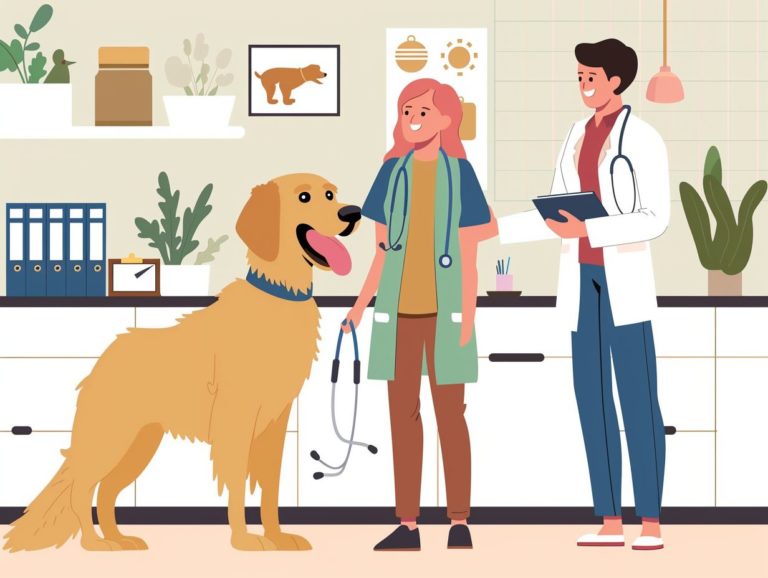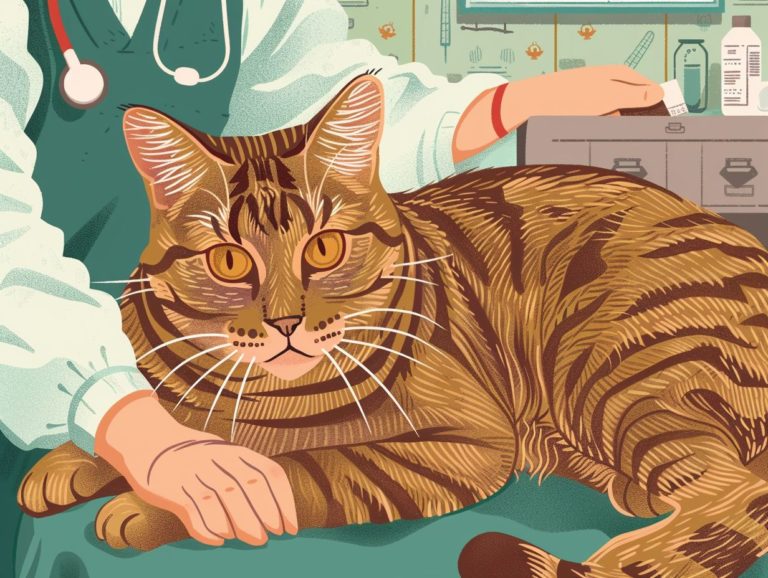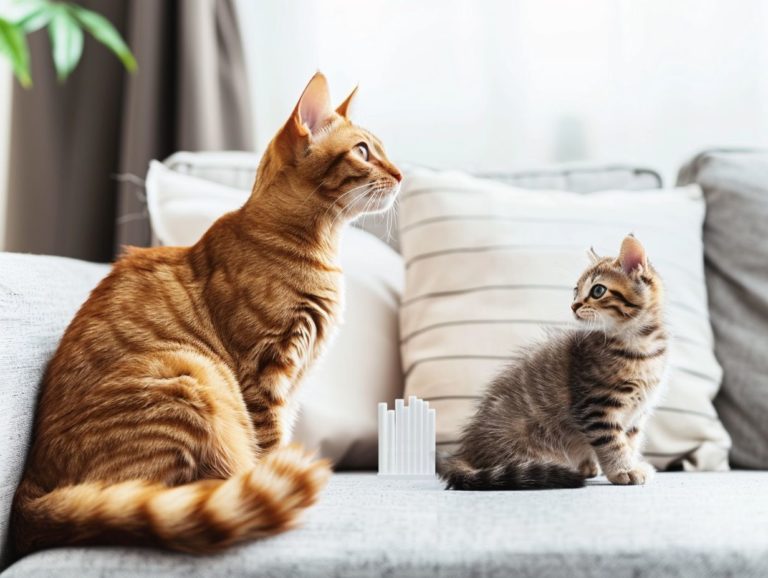Is There A Best Time To Buy A Cat Health Plan
This comprehensive guide outlines a cat health plan, detailing its coverage and benefits. It explores key factors to consider when purchasing a cat health plan and offers 12 tips for selecting the most suitable one for your cat.
Beyond meeting basic needs, caring for your pet involves ensuring they have access to essential medical care when needed. This guide aims to equip cat owners with the necessary information to comprehend the purpose of cat health plans and make informed decisions for their feline companions, whether they currently own a cat or are planning to acquire one.
Key Takeaways:
Understanding Cat Health Plans
Cat Health Plans are insurance options designed to protect the health and well-being of your feline pets. These plans offer coverage and assistance to pet owners in managing veterinary care costs and promoting the health of their pet cats.
Having a cat health plan provides policyholders in California with peace of mind, knowing that their cats are safeguarded in case of unexpected illnesses or accidents. Reputable insurance companies like Lemonade, ASPCA, and others offer a range of plans to accommodate various budget constraints and provide different levels of coverage.
These plans typically include coverage for vet visits, vaccinations, surgeries, and medications, allowing cat owners to prioritize their cats’ health without financial concerns.
What is a Cat Health Plan?
A Cat Health Plan is an insurance policy specifically designed for cat owners to cover medical expenses, treatments, preventive care, and emergency treatments. These plans are tailored to meet the unique healthcare needs of cats, providing cat owners with financial assistance during critical times.
Services typically included in a Cat Health Plan are vaccinations, check-ups, dental care, and coverage for chronic conditions. Unlike traditional pet insurance policies that may not address a cat’s specific health requirements, Cat Health Plans are comprehensive and cater to all aspects of a cat’s health. They also offer additional benefits such as 24/7 helplines for veterinary advice, nutritional guidance, and complementary therapies.
Types of Cat Health Plans
There are different types of Cat Health Plans available, including comprehensive coverage plans, wellness plans, and accident-only plans. These plans offer varying levels of protection and benefits to cat owners, allowing them to select a plan that suits their cat’s specific needs.
Comprehensive coverage plans usually encompass a wide range of services such as vaccinations, regular check-ups, dental care, and emergency treatments, making them ideal for cat owners seeking extensive coverage for their cat’s overall well-being.
Wellness plans typically focus on preventive care, offering services like annual exams, parasite control, and nutrition counseling to promote the cat’s wellness through routine monitoring and preventative measures, although they may not cover emergency services.
Accident-only plans are designed to cover unexpected injuries or medical emergencies, providing coverage for incidents such as broken bones or ingestion of foreign objects.
Benefits of Buying a Cat Health Plan
Cat Health Plans offer pet owners financial security and peace of mind by providing protection against unexpected medical expenses and ensuring timely and quality veterinary care for their cats. By investing in a cat health plan, pet owners can alleviate the financial burden and stress of unexpectedly high veterinary costs.
With veterinary care expenses on the rise, having planned financial coverage can be crucial in emergency situations. Many cat health plans cover routine check-ups, vaccinations, and preventive treatments, promoting the overall health and well-being of cats. This proactive approach not only saves money in the long term but also maintains the cat’s health and happiness, strengthening the bond between pet owners and their feline companions.
Financial Benefits
Cat Health Plans offer financial benefits by covering some or all of the costs associated with veterinary treatment, surgeries, medications, and preventive medical care. This financial assistance allows cat owners to provide essential healthcare for their pets without worrying about the expenses.
Typically operating on a reimbursement basis, these plans require pet owners to pay for the services upfront and then submit their veterinary bills to the insurance company to receive a percentage of the costs refunded. This reimbursement model not only promotes regular veterinary visits but also provides support for unexpected medical expenses.
By alleviating the financial stresses related to cat health, these plans encourage preventative care and ensure that cats receive necessary and timely treatment.
Health Benefits for Your Cat
Cat Health Plans not only provide financial coverage but also ensure the provision of essential healthcare services necessary for maintaining good health in a cat. Regular check-ups, vaccinations, and emergency treatments are all included in the health benefits offered by these plans to cat owners.
Enrolling a cat in a health plan helps to prevent potential health issues and address them promptly if they arise. Preventative care, such as dental cleanings and parasite control, plays a key role in keeping your cat healthy and happy for a longer period.
The financial stability offered by a health plan guarantees that emergency care can be administered without causing financial strain. These plans contribute to enhancing the overall quality and lifespan of one’s cat.
Factors to Consider When Choosing a Cat Health Plan
Factors that influence the selection of a Cat Health Plan include coverage options, costs, exclusions, and limitations, as they determine whether the plan will meet the medical requirements of the pet owner’s cat.
To determine a suitable Pet Health Plan, it is essential to compare the benefits of different plans and understand the terms of coverage. Coverage details play a crucial role in selecting a good health insurance plan for cats, with the best plans covering preventive care, vaccinations, annual vet check-ups, and emergency medical care.
Evaluating costs, including premiums, deductibles, co-pays, and any out-of-pocket expenses, along with terms, waiting periods, pre-existing conditions, and breed-specific limits, is also important. By exploring multiple options, a balanced approach can be achieved between comprehensive coverage and affordability for your cat.
Coverage and Cost
When considering a Cat Health Plan, the coverage and cost are the two main factors that impact the suitability of the plan for your cat’s health needs. Understanding the extent of coverage, deductibles, co-pays, and monthly premiums is crucial for pet owners to ensure that the benefits align with their financial capabilities.
By comprehending which expenses the policy covers and the owner’s out-of-pocket responsibilities, pet owners can ensure their cat receives necessary care without overspending. The ideal plan is one that provides adequate coverage for potential cat needs while also being financially viable.
It is important for individuals to examine annual limits, waiting periods, and coverage for chronic conditions to optimize their insurance benefits.
Exclusions and Limitations
Understanding the exclusions and limitations of a Cat Health Plan is crucial to avoid unexpected costs and coverage gaps. Pet owners need to familiarize themselves with the terms and conditions of the policy to identify which conditions, treatments, or services are not covered. This knowledge allows them to ensure that the health needs of their cats are adequately met.
Common exclusions in cat health plans typically encompass pre-existing conditions, elective procedures like cosmetic surgeries, and certain hereditary conditions. Limitations may involve annual maximum limits, waiting periods, and restrictions on specific treatments or diagnostic procedures. Being aware of these exclusions and limitations is essential as they significantly impact the scope of coverage and financial obligations for pet owners, influencing the level of care they can provide for their feline companions.
When is the Best Time to Buy a Cat Health Plan?
The optimal time to purchase a Cat Health Plan is when your cat is young and in good health, as the premiums are lower and the coverage is more comprehensive. However, it is never too late to invest in a plan to safeguard your cat’s well-being.
As cats age, they are more prone to developing health issues. While these can be addressed under insurance, if they manifest before obtaining coverage, they may be classified as pre-existing conditions. Securing coverage early eliminates concerns about pre-existing conditions for your cat and enables you to take a proactive approach to addressing health issues.
Initiating coverage early allows for uninterrupted coverage without any waiting period for pre-existing conditions, ensuring a smooth and stress-free experience during unforeseen medical emergencies.
Age and Health of Your Cat
The optimal time to purchase a Cat Health Plan depends on your cat’s age and current health condition. Enrolling your cat at a younger age and in good health typically results in lower premiums and broader coverage, making early enrollment the ideal choice for most pet owners.
As cats age, they are more prone to developing underlying health issues, which can affect their insurance eligibility and coverage scope. By enrolling your cat at a younger age and while they are healthy, you can secure comprehensive coverage at more affordable rates and ensure a wider range of potential future health concerns will be included in the plan.
Early enrollment offers financial security and peace of mind, knowing that your cat’s future healthcare needs are well protected.
Considerations for Multi-Cat Households
Investing in a Cat Health Plan for each cat in a multi-cat household is advantageous for the overall health and well-being of the feline companions. Given the distinctive dynamics of multi-cat environments, insuring each cat separately allows for tailored solutions that cater to the individual needs of each cat. This approach ensures comprehensive coverage for all cats, facilitating more effective healthcare management.
Separate insurance for each cat guarantees that any specific health issues or pre-existing conditions unique to that cat receive appropriate attention. This supports targeted treatments tailored to the individual cat’s needs and enhances preventive care, ultimately boosting the cat’s overall health and wellness.
While insuring multiple cats individually may appear costly initially, it often leads to long-term cost savings by eliminating redundant coverage and enabling customized premiums based on each cat’s unique health profile.
Tips for Finding the Right Cat Health Plan
Choosing the best Cat Health Plan involves careful research, comparison, and recommendations from other cat owners and veterinary professionals. It is essential to research which plan will best suit your cat’s specific health needs, as well as the ones that provide coverage for the common health risks of the breed.
The best coverage plans for cats include preventative care such as check-ups and vaccines, emergency care, chronic condition management, as well as congenital and hereditary conditions. Reviewing each plan’s exclusions and limitations on coverage is crucial as they directly impact your cat’s care and health.
Inquire about the ease of making claims, the time for reimbursement, and the satisfaction rates of customer service to ensure that an insurance provider is reliable.
Research and Compare Plans
To assist pet owners in finding the best insurance for their cats, it is essential to research and compare various Cat Health Plans. By evaluating policy details, coverage limits, reimbursement processes, and customer reviews, pet owners can identify the insurance policy that best suits their cat’s healthcare needs and financial situation.
Understanding the policy details enables pet owners to comprehend the extent of insurance coverage for different medical conditions and treatments. Knowledge of coverage limits helps pet owners ensure that significant healthcare expenses will be covered without exceeding the limits.
Customer feedback allows pet owners to evaluate the level of satisfaction and service quality provided by the insurance provider, enabling them to assess the company’s reliability. Cost comparisons among different plans assist pet owners in selecting an affordable yet comprehensive plan that strikes a good balance between insurance premiums and coverage benefits.
Ask for Recommendations
Recommendations from reputable sources such as other pet owners, veterinarians, and trustworthy websites can help in finding reliable Cat Health Plans. Personal and professional experiences-based recommendations can assist pet owners in identifying insurance providers offering the best coverage and customer service for their cats.
Insights into the effectiveness and coverage of various plans can be gained from personal recommendations from other cat owners who have utilized cat health plans. Veterinarians, with their experience in diagnosing and treating a wide range of conditions in cats, can offer valuable insights into which insurance providers provide the best preventive care and medical treatment services for cats.
Online reviews play a crucial role in understanding the reputation and customer satisfaction rates of different cat health plan providers, enabling pet owners to make well-informed decisions for their cats.
Frequently Asked Questions
Is There a Best Time to Buy a Cat Health Plan?
The best time to buy a cat health plan is before your cat gets sick or injured. It’s important to have coverage in place as soon as possible to avoid any gaps in care.
Can I Buy a Cat Health Plan at Any Time?
Yes, you can purchase a cat health plan at any time. However, it’s recommended to do so as early as possible to ensure maximum coverage and avoid any pre-existing condition exclusions.
What are the Benefits of Buying a Cat Health Plan Early?
Buying a cat health plan early allows you to lock in lower rates and avoid any potential pre-existing condition exclusions. It also ensures that your cat is covered in case of any unexpected health issues.
Is There a Waiting Period for Coverage to Begin?
Most cat health plans have a waiting period before coverage begins. This is typically anywhere from 14-30 days, but it may vary depending on the plan. It’s important to check with your provider for specific details.
Will My Cat’s Age Affect the Cost of a Health Plan?
Yes, the age of your cat can impact the cost of a health plan. Generally, younger cats will have lower premiums compared to older cats. It’s important to consider this when choosing a plan and purchasing coverage as early as possible.
What Should I Look for in a Cat Health Plan?
When looking for a cat health plan, it’s important to consider the coverage options, premiums, and deductibles. You should also look into the provider’s reputation and customer reviews to ensure you are choosing a reliable and reputable plan for your cat’s health needs.



